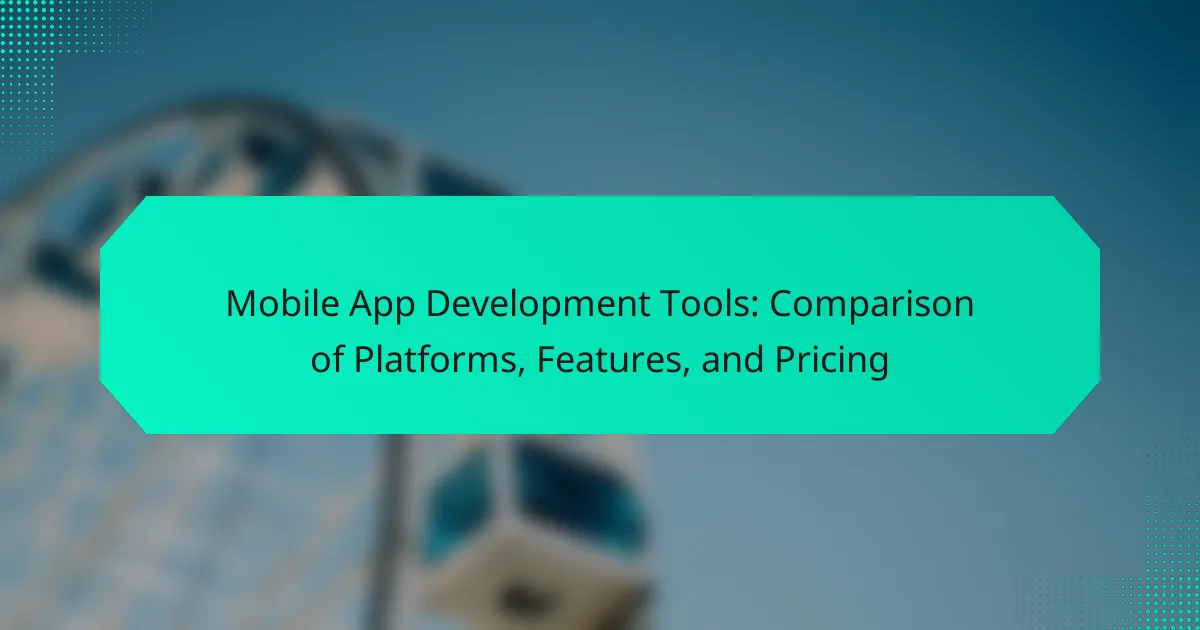Mobile app development tools are essential software applications that facilitate the creation of mobile applications by providing coding assistance, debugging, and testing features. Key tools in the industry include Android Studio for Android apps and Xcode for iOS apps, supporting various programming languages such as Java, Swift, and Kotlin. This article explores the critical features of these tools, including cross-platform compatibility, user-friendly interfaces, and extensive libraries, which enhance development efficiency. Additionally, it examines the diverse pricing models available for these tools, such as subscription-based, one-time purchase, freemium, and usage-based pricing, highlighting the projected growth of the mobile app development market.

What are Mobile App Development Tools?
Mobile app development tools are software applications that assist developers in creating mobile applications. These tools streamline the development process by providing features such as coding assistance, debugging, and testing. Popular mobile app development tools include Android Studio for Android apps and Xcode for iOS apps. They often support multiple programming languages, such as Java, Swift, and Kotlin. Many tools also offer pre-built templates and libraries to accelerate development. According to a report by Statista, the global mobile app development market is expected to reach $407.31 billion by 2026, highlighting the importance of these tools in the industry.
How do Mobile App Development Tools facilitate app creation?
Mobile app development tools facilitate app creation by providing pre-built templates and components. These tools streamline the development process, reducing the need for extensive coding. They often include drag-and-drop interfaces, making it easier for users to design apps visually. Many tools also offer cross-platform capabilities, allowing developers to create apps for multiple operating systems simultaneously. Additionally, these tools provide integration with APIs, enhancing functionality without complex programming. Analytics and testing features are commonly built-in, enabling developers to optimize performance. According to a 2022 report by Statista, 45% of developers use these tools to accelerate their workflow.
What are the key functionalities of these tools?
Mobile app development tools primarily enable the creation, testing, and deployment of applications. They provide functionalities such as code editing, debugging, and performance monitoring. Many tools offer cross-platform compatibility, allowing developers to build apps for multiple operating systems simultaneously. Integration with APIs and third-party services is also a common feature. User interface design capabilities help developers create visually appealing apps. Additionally, version control systems are often included to manage code changes effectively. Analytics and reporting tools provide insights into app performance and user engagement. Lastly, cloud services facilitate storage and collaboration among development teams.
How do these tools integrate with various platforms?
Mobile app development tools integrate with various platforms through APIs and SDKs. These tools often provide built-in support for popular operating systems like iOS and Android. They allow developers to connect their apps to third-party services seamlessly. Integration capabilities include cloud services, social media, and analytics platforms. Many tools offer cross-platform development options to streamline the process. For example, frameworks like React Native enable code sharing between iOS and Android. This reduces development time and costs. Additionally, tools often feature plugins to enhance functionality across different platforms.
What types of Mobile App Development Tools are available?
There are several types of mobile app development tools available. These tools can be categorized into native, hybrid, and cross-platform development environments. Native development tools include Android Studio for Android apps and Xcode for iOS apps. Hybrid development tools, such as Ionic and Apache Cordova, allow developers to create apps using web technologies. Cross-platform tools like React Native and Flutter enable the development of apps for multiple platforms from a single codebase. Each type of tool has its unique benefits and use cases. For instance, native tools provide optimal performance and access to device features. In contrast, hybrid and cross-platform tools offer faster development and easier maintenance.
What distinguishes native, hybrid, and web app development tools?
Native app development tools create applications specifically for one platform, such as iOS or Android. They utilize platform-specific languages and APIs, ensuring optimal performance and access to device features. Hybrid app development tools combine elements of both native and web applications. They allow for cross-platform development using web technologies like HTML, CSS, and JavaScript, providing a balance between performance and development speed. Web app development tools create applications that run in a web browser. They are platform-independent and require an internet connection, focusing on accessibility over native device features. Each type of tool has unique strengths and weaknesses, influencing the choice based on project requirements.
How do cross-platform tools compare to platform-specific tools?
Cross-platform tools enable developers to create applications for multiple platforms using a single codebase. This approach saves time and resources compared to platform-specific tools, which require separate codebases for each platform. Cross-platform tools often offer a wider reach since they target various operating systems like iOS and Android simultaneously. In contrast, platform-specific tools provide optimized performance and access to native features unique to each platform. For instance, tools like React Native allow for near-native performance, while Swift is tailored for iOS development. According to a 2021 survey by Statista, 42% of developers prefer cross-platform tools for their efficiency, while 30% choose platform-specific tools for performance advantages.

What are the key features of Mobile App Development Tools?
Key features of mobile app development tools include cross-platform compatibility, user-friendly interfaces, and extensive libraries. Cross-platform compatibility allows developers to create apps for multiple operating systems using a single codebase. User-friendly interfaces simplify the development process, making it accessible for beginners. Extensive libraries provide pre-built components and functionalities, speeding up development time. Additionally, debugging and testing tools help ensure app quality. Integration with third-party services enhances app functionality. Finally, cloud services support data storage and scalability. These features collectively improve efficiency and effectiveness in mobile app development.
How do user interface design features impact app development?
User interface design features significantly impact app development by influencing user experience and functionality. A well-designed interface enhances usability, making apps more intuitive for users. This can lead to increased user engagement and satisfaction. Conversely, poor design can result in user frustration and abandonment. Research indicates that 94% of first impressions relate to design. Additionally, design features affect the app’s performance and development time. Complex interfaces may require more development resources and time. Therefore, prioritizing user interface design is essential for successful app development.
What design tools are commonly included in development platforms?
Development platforms commonly include design tools such as wireframing tools, UI/UX design applications, and prototyping software. Wireframing tools help visualize the layout and structure of an app. UI/UX design applications allow for the creation of user interfaces and experiences. Prototyping software enables developers to create interactive mockups of applications. These tools facilitate the design process, ensuring that developers can create user-friendly and visually appealing applications. Popular examples of these tools include Sketch, Adobe XD, and Figma. Each of these tools is widely recognized in the industry for their effectiveness in mobile app development.
How do these features enhance user experience?
These features enhance user experience by providing intuitive interfaces and seamless navigation. User-friendly design reduces learning curves and increases engagement. Responsive performance ensures quick load times and smooth interactions. Customization options allow users to tailor the app to their preferences. Integration with other services enhances functionality and convenience. Regular updates keep the app relevant and improve security. User feedback mechanisms facilitate continuous improvement. All these factors contribute to higher user satisfaction and retention rates.
What programming languages are supported by various tools?
Mobile app development tools support various programming languages. Commonly supported languages include Java for Android development, Swift for iOS development, and JavaScript for cross-platform frameworks. Tools like React Native support JavaScript, allowing for mobile app development on both iOS and Android. Flutter primarily uses Dart as its programming language for building mobile applications. Xamarin supports C# for cross-platform app development. Additionally, tools like Apache Cordova allow developers to use HTML, CSS, and JavaScript for mobile applications. Each tool’s documentation provides detailed information on supported languages.
Which languages are most commonly used for mobile app development?
Java and Swift are the most commonly used languages for mobile app development. Java is primarily used for Android app development. It has a large ecosystem and extensive libraries. Swift is the preferred language for iOS app development. It offers modern syntax and performance advantages. Additionally, Kotlin has gained popularity for Android development. It is fully interoperable with Java. React Native and Flutter use JavaScript and Dart, respectively. These frameworks enable cross-platform app development. The choice of language often depends on the target platform and developer expertise.
How does language support affect development efficiency?
Language support enhances development efficiency by providing developers with tools and resources that streamline coding processes. It allows for better communication between team members, reducing misunderstandings and errors. Language support includes features like syntax highlighting, code completion, and error detection. These features help developers write code faster and with fewer mistakes. According to a study by Microsoft, integrated development environments (IDEs) with robust language support can increase productivity by up to 30%. This efficiency translates into faster project completion and lower development costs.

How do pricing models for Mobile App Development Tools vary?
Pricing models for mobile app development tools vary significantly. They can be categorized into several types. Subscription-based models charge users a recurring fee, often monthly or annually. One-time purchase models require a single upfront payment for lifetime access. Freemium models offer basic features for free, with premium features available for a fee. Usage-based pricing charges based on the volume of usage or features utilized. Some tools offer tiered pricing, where costs increase with additional features or user limits. According to a report by Statista, the global mobile app development market is projected to grow, influencing the diversity of pricing models available. This variation allows developers to choose tools that fit their budget and project needs.
What are the common pricing structures for these tools?
Common pricing structures for mobile app development tools include subscription-based, one-time payment, and freemium models. Subscription-based pricing often involves monthly or annual fees. This model provides ongoing updates and support. One-time payment structures require a single upfront cost for perpetual access. Freemium models offer basic features for free, with optional premium features available for a fee. According to a 2022 report by Statista, 30% of app development tools utilize subscription-based pricing. This indicates a trend towards recurring revenue models in the industry.
How does subscription pricing compare to one-time purchase models?
Subscription pricing offers ongoing access to services for a recurring fee, while one-time purchase models require a single upfront payment for permanent ownership. Subscription models can provide continuous updates and support, which enhances user experience over time. In contrast, one-time purchases may involve additional costs for upgrades or support. Research indicates that 70% of consumers prefer subscriptions for the flexibility they offer. Additionally, subscription models can lead to higher long-term revenue for companies, as they create a steady income stream. One-time purchases can result in larger initial sales but may not sustain revenue over time.
What additional costs should developers consider?
Developers should consider costs related to ongoing maintenance and updates. These costs can arise from fixing bugs, implementing new features, and ensuring compatibility with new operating system versions. Additionally, developers must account for server hosting fees, which can vary based on traffic and data storage needs. Licensing fees for third-party tools or APIs are also significant. Training costs for team members on new technologies or tools should not be overlooked. Marketing expenses are essential for app promotion post-launch. Finally, costs associated with app store fees for distribution should be factored in.
What factors influence the cost of Mobile App Development Tools?
The cost of mobile app development tools is influenced by several key factors. First, the complexity of the app being developed affects the tool’s pricing. More complex apps require advanced features, which can increase costs. Second, the platform compatibility plays a significant role. Tools that support multiple platforms often have higher prices due to their versatility. Third, licensing models impact costs. Some tools offer one-time purchases, while others use subscription-based pricing, which can vary over time. Fourth, the level of support and documentation available can influence costs. Comprehensive support usually comes at a higher price. Finally, the reputation and market demand for specific tools can drive costs up. Popular tools with a strong user base often command higher prices due to their perceived value.
How do features and capabilities affect pricing?
Features and capabilities significantly influence pricing in mobile app development tools. More advanced features typically justify higher prices. For instance, tools with robust analytics, cloud integration, or extensive libraries charge more due to their added value. Capabilities like cross-platform support often lead to premium pricing. This is because they save developers time and resources. Additionally, tools that offer user-friendly interfaces or enhanced security features may also command higher prices. According to a report by Statista, tools with comprehensive features can be priced up to 30% higher than basic alternatives. Ultimately, the pricing structure reflects the development tool’s functionality and the value it provides to users.
What role does customer support play in pricing decisions?
Customer support plays a crucial role in pricing decisions for mobile app development tools. It influences perceived value and customer satisfaction. High-quality support can justify premium pricing. Conversely, inadequate support may lead to price reductions or loss of customers. Companies often analyze customer feedback to adjust pricing strategies. Data from surveys indicates that 70% of customers consider support quality when deciding on a purchase. Therefore, effective customer support can enhance customer loyalty and retention, impacting long-term pricing strategies.
What are the best practices for choosing Mobile App Development Tools?
Identify the specific requirements of your mobile app project. Consider factors such as target audience, platform compatibility, and desired features. Evaluate the development tools’ ease of use and learning curve. Research the community support and resources available for each tool. Analyze the pricing models and total cost of ownership for the tools. Check for integration capabilities with existing systems and APIs. Assess the scalability and performance of the tools to ensure they meet future needs. Review case studies or testimonials from other developers to gauge effectiveness.
How can developers assess their specific needs before selecting a tool?
Developers can assess their specific needs by evaluating project requirements. They should identify the target platform for the mobile app. Understanding the audience and their preferences is crucial. Developers must also consider the app’s complexity and required features. Budget constraints play a significant role in tool selection. They should analyze the tools’ compatibility with existing workflows. Assessing the learning curve associated with each tool is important. Finally, reviewing user feedback and case studies can provide valuable insights.
What are the common pitfalls to avoid when choosing these tools?
Common pitfalls to avoid when choosing mobile app development tools include overlooking platform compatibility. Ensuring the tool supports both iOS and Android is crucial. Another pitfall is ignoring user experience. A tool that complicates the development process can lead to poor app performance. Additionally, neglecting community support can hinder problem-solving. Tools with active communities provide better resources and troubleshooting. Cost is also a significant factor. Choosing tools without understanding the total cost of ownership can lead to budget overruns. Lastly, failing to evaluate scalability can restrict future growth. Selecting tools that cannot adapt to increasing user demands limits app potential.
Mobile app development tools are software applications that aid developers in creating mobile applications, offering features like coding assistance, debugging, and testing. This article provides a comprehensive comparison of various mobile app development platforms, including native, hybrid, and cross-platform tools, detailing their functionalities, key features, and programming language support. Additionally, it examines the pricing models associated with these tools, highlighting factors that influence costs and best practices for selecting the right tools for app development projects. Insights into user interface design’s impact on user experience and common pitfalls to avoid during tool selection are also discussed.


